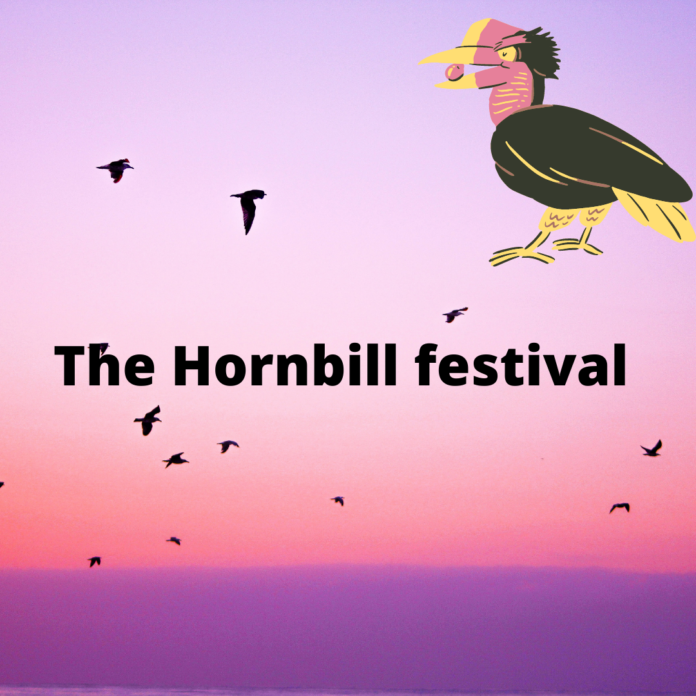Showcased behind thick glass the most famous statue in the world cannot be easily missed in the Museum of Contemporary Art, Bangkok, the statue of The Great Hornbill Lady. We have to be vigilant to her existence there, amid other plastered statues, potsherds and bronze idols, to recoup this dark bronze whose image is anchored and embedded in minds of the Naga people. Her figurine indeed serves as a remembrance for the people of Nagaland during the Annual Hornbill festival known widely as the ‘festival of festivals, a celebration not only about reliving the past but also the present.
Nestled in the northeastern region of India, Nagaland has its ory; a satiny land which the brave Naga warriors fiercely protected, a land with indigenous who held their traditions amidst time with great vanity. Times have changed. Elephants and tigers do not caper across the Naga terrain nowadays but hornbills still do. Both during day and night, they hover across the land.
Organized by the State Tourism and Art & Culture Department of Nagaland, the first-ever Hornbill festival was launched on December 1st, 2000. This festival usually takes place from 1st December, the day on which Nagaland attained statehood, to the 7th of December, annually. Recent statistics reveal that this majestic festival attracts tourists around the world; hence, the Hornbill Festival has been extended till the 10th of December. It is not clear who initiated this festival, but its origins are now urban legends. It is named famously as the ‘Hornbill Festival’ as these colourful birds that play a major role in most of their folklores are much revered and admired.
The hornbill festival offers a mélange of cultural activities at the model village built at Kisama, a small village situated twelve kilometres from Kohima, the heart of Nagaland. The goal and outcome of this festival are to shield and revive the opulent culture. It not only highlights Nagaland’s traditions but also offers an opportunity for tourists and natives to waltz through the dances, sing songs and eat to their heart’s content. Moreover, it touches on the theme of the preservation of Naga culture.
The events of the Hornbill festival commences at 9 am and continues till dusk. The festival is usually inaugurated by official dignitaries such as the Governor, state Chief Minister and other politicians. Further, the Naga head pastor begins the traditional Nagaland chant, which is later followed by the festive events by the sixteen tribes of the Naga community. All the sixteen tribes are given slots to perform their songs, dances, stories and fashions. Once the performance is through in the amphitheatre, each of the tribal performers goes to their traditional morning or dormitory. Mornings are a prominent feature of the Naga society. It was the venue where young people were trained in the art of war, weaving, dance, customs and traditions. Tourists can visit each morning, interact with the performers, take photographs and taste tribal delicacy sold in the morning Visitors can indulge in a plethora of sports activities such as Naga wrestling, traditional archery, horseback riding, and athletic events as well.
The most exhilarated year was 2014, when the Prime Minister of India, Narendra Modi, inaugurated it.
The paramount attraction of the Hornbill festival is the chilli eating competition. This is indeed a tough game as the famous Naga King Chili is the second-hottesttttt chillis on h. Natives and tourists barely make it across. Games are followed by cuisine for everyone. The traditional food served in various stalls and at all the mornings is truly delectable. The staple food of the Naga community is brown rice and pork, which is the juiciest meat. It is served with a beef pickle and a variety of Naga chutneys. Also, there are several options for vegetarians including local and organic fresh fruits as well.
Apart from these activities, traditional arts and crafts are also featured with woodcarvings, paintings and sculptures by modern Naga artists. Cultural groups from all the tribes sing folk songs, perform traditional dances and play indigenous games and sports. It is also a marvellous time for music lovers as Hornbill Festival organizes music concerts featuring local artists and renowned singers catering to all tastes. One mega highlight of this festival is the Hornbill International Rock Festival which is held at Indira Gandhi Stadium where local and international rock bands perform. The same schedule is followed till the 10th of December, but with more varieties.
However, the festive has its cons too. Firstly, the majority of locals have not been trained or imparted information about the benefits of tourism, so most locals carry on with their daily lives rather than helping tourists. Secondly, as Nagaland promotes tourism mostly for Hornbill Festival which is just for 10 days, not many natives are interested in setting up hotels or lodging facilities for tourists. What happens as a result of this is a shortage of lodging and transportation facilities when there is a sudden rush of tourists during this period.
Finally yet importantly, what began as a village festival to generate more tourists and to bring together the different Naga tribes from all over Nagaland has become a global event that encompasses a variety of activities. Not only does the festival attract people from all over the world, but it has also given Nagaland an international reputation as a travel destination. There is hardly any dull moment during the Hornbill festival. Moreover, it reminds us why it is important to visit and experience thereefththe sheettions and cultures of India.











GREAT WORK MAHNN!!✌👌